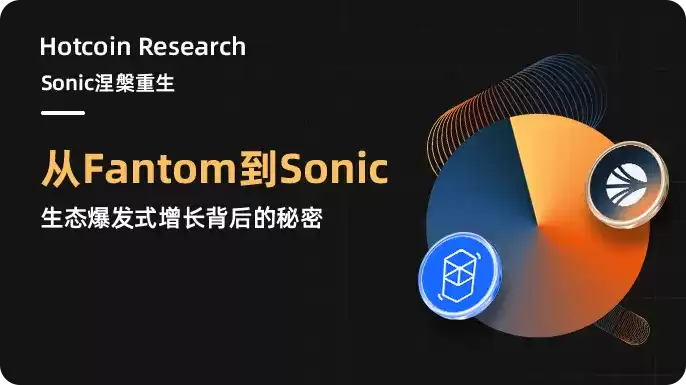Since Fantom upgraded to Sonic, the on-chain TVL and tokens have shown explosive growth trends.

Introduction
Since Fantom upgraded to Sonic and announced a series of new plans, both the on-chain TVL and tokens have shown explosive growth trends. The introduction of the new FVM virtual machine, Carmen storage system, and Sonic Gateway has brought continuous development momentum to the ecosystem. Moreover, the return of Andre Cronje and his influence in the DeFi field help attract quality projects to join Sonic and promote a positive cycle of the Sonic ecosystem through his four visions (fee monetization, transaction fee subsidies, dynamic fees, and native economic account abstraction). The upgrade from Fantom to Sonic marks a rebirth for this veteran public chain, making Sonic one of the fastest-growing emerging chains. As long as the ecosystem's popularity and capital inflow are maintained, Sonic's TVL is expected to further increase, potentially challenging the locked asset scale of traditional mainstream public chains. This article will delve into the key data and driving factors behind the growth of the Sonic ecosystem, focusing on its technological upgrades, popular projects, and token market performance, and explore the new trends and investment opportunities in DeFi that Sonic may lead in the future.
Changes from Fantom to Sonic Upgrade
The renaming and upgrading of Fantom to Sonic is not just a change of name, but also represents significant improvements in the underlying architecture. The core of this upgrade includes the Fantom Virtual Machine (FVM), storage system optimization (codenamed Carmen), and the Sonic Gateway cross-chain gateway. These upgrades aim to comprehensively enhance network performance, scalability, and interoperability, providing a better experience for developers and users.
1. Technical Upgrade Content
1) Fantom Virtual Machine (FVM): Sonic introduces its self-developed FVM to replace the original EVM execution environment. FVM is fully compatible with EVM, allowing existing Ethereum contracts to be seamlessly migrated to Sonic, reducing development and migration costs. More importantly, FVM has been deeply optimized for parallel processing and instruction sets, with its smart contract execution speed and throughput improved several times compared to EVM. Test results show that FVM improves transaction processing speed by 8.1 times and reduces on-chain data storage requirements by 98%. This means that on Sonic, transaction confirmations can be completed in sub-second levels, with users hardly feeling any delay; at the same time, network resource utilization is higher, consuming less computational and storage resources per transaction. For developers, FVM provides more comprehensive debugging tools and supports more programming languages beyond Solidity and Vyper, giving developers more flexibility. In summary, FVM greatly alleviates the performance bottlenecks of the previous EVM, providing a fertile ground for complex DApps on Sonic. 2) Carmen Storage System Optimization: As the blockchain runs over time, the explosive growth of state data can place a heavy burden on nodes. To address this, Sonic has adopted a brand new Carmen state database. This solution can trim and compress historical data on demand, significantly reducing the storage requirements for nodes. After the upgrade, the amount of data required to run a validating node has decreased from about 2000GB to 300GB; the storage requirements for a full archival node have dropped from over 11TB to less than 1TB. The drastic reduction in storage burden lowers the operational costs for nodes, enabling more ordinary participants to run nodes, thereby increasing the network's decentralization and security. At the same time, Carmen supports parallel processing of data requests, maintaining efficient responses even under high loads. For frequently accessed data (such as DeFi protocol states), the system employs intelligent strategies to ensure fast reading, while older and less frequently used data is compressed and archived. All of this ensures that the Sonic network can maintain performance and scalability at a low cost even in large-grade application scenarios. 3) Sonic Gateway Cross-Chain Gateway: To enhance interoperability with ecosystems like Ethereum, Sonic has launched the native cross-chain bridge Sonic Gateway. It is a decentralized bridging solution that connects the Ethereum mainnet and the Sonic network, enabling secure two-way cross-chain asset transfers. Through Sonic Gateway, users can quickly transfer ERC-20 assets from Ethereum to Sonic (arriving in about 10 minutes), while transferring back from Sonic to Ethereum takes about 1 hour. The bridge has a comprehensive security mechanism, such as built-in fault protection: if the gateway is unusable for 14 consecutive days, users can retrieve their original assets on the Ethereum side, eliminating the risk of assets being locked for long periods. Additionally, the gateway monitors the status of both ends through cross-chain "heartbeat" signals to ensure the safety of user funds. Compared to typical Ethereum Layer 2 solutions, Sonic's cross-chain transfers do not require a 7-day challenge period. It is worth mentioning that while Sonic is highly integrated with Ethereum, it is not a Layer 2 expansion but a hybrid L1+L2 network: from Ethereum's perspective, Sonic connects to the mainnet like an L2, but it remains an independent L1,
Clause de non-responsabilité:info@kdj.com
Les informations fournies ne constituent pas des conseils commerciaux. kdj.com n’assume aucune responsabilité pour les investissements effectués sur la base des informations fournies dans cet article. Les crypto-monnaies sont très volatiles et il est fortement recommandé d’investir avec prudence après une recherche approfondie!
Si vous pensez que le contenu utilisé sur ce site Web porte atteinte à vos droits d’auteur, veuillez nous contacter immédiatement (info@kdj.com) et nous le supprimerons dans les plus brefs délais.




















































































